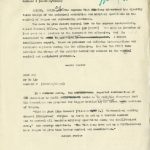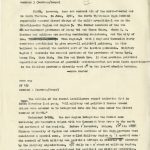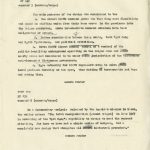1967, April 24, “Political Activities and Military Operations”
zczc sag
yy ljp
command 1 (normass/deepe) VC May off
SAIGON, APRIL 2324–The supreme Viet Conc Cong coo command has directly taken charge of the political activities and military operations in the capital of Saigonand surrounding provinces.
The move to give direct control the to the supreme headquarters, called Central Office, South Vietnam (cos COSVN) was made in November of last year as a prelude to the Communist Tet offensive, and is considered to still be currently operative in the current period. A recent intelligence report, based on prisoner and defector interrogations and documents captured during the Tet offensive, has for the first time detailed the change of the political-military command in the capitol capital and peripheral provinces.
==more reuter
zczc sag
yy lu ljp
command 2 (normass/deepe)
In a command sense, the continuation reported continuation of the direction by COSVN would soon to indicates to reliable observers that the Communists are prepared for bigger battles in or near the urban and sections of Saigon.
“This is just like General (William Wst C.) Westmorland sending General (Creighton) Abrahms up north to set up a forward command and to control all American military operations along the demilitarized zone,” one source explained. “The Viet Cong have set up a COSVN-forward near Saigon to give them better control and coordination.”
==more reuter
zczc sag
yy ljp
command 3 (normass/deep)
COSVN, however, does not control all of the multi-faceted war in South Vietnam. In June, 1966, the North vietnamese High Command reportedly assumed direct charge of the military-political war in the Tri-Thien-Hue Region and Region 5. The former consists of the two nhi northernmost provinces of Quang Tri and Thuan Thien, where U. S. Marines and soldiers are meeting continuing resistence, and the city of Hue. Military Region 5 This region,x with a regional Communist Party committee established to give over-all political guidance, is also believed to control the central part of the Laotian panhandle. Military Region 5 controls the coastal portions of the provinces of Quang Ngai, Quang Tin, Binh Dinh, Phu Yen and Khanh Hoa. It also provides political supervision and direction of guerrilla activities–but not main force operations–in the highland provinces directly west ot to the Laos-Cambodian borders.
==more reuter
zczc sag
yy ljp
command 4 (normass/deepe)
The details of the recent intelligence report indicates that in Nobem Novemeber last year, “all military and political forces around Saigon were ordered to be integrated into one big zone under the direct command of COSVN.”
Codenamed T-700, the new region integrates the former zone including greater-urban Saigon with the Communist base areas to the north and northwest of the captial. Before t November, Saigon, it’ its twln Chinese twin-city of Cholon and suburban sections of Gia Dinh province were considered a special zone, later called Military Region 4. IN A special zone, the control of both military and political affairs is directly by directed by the military organizations, wyi while in a n standard military region, separate structures are established for political and military activities. The provinces, forme forming Military Region 1, fanning into a wide arc north of Saigon from Cambodia to the South China Sea, has now been integrated with Saigongreater urban Saigon to form T-700.
==more Reuter
zczc sag
yy ljp
command 5 (normass/deep)
The main purposes of the change are considered to be:
1. The direct COSVN command gives the Viet Cong more flexibility and speed in shifting units from their base areas in the provinces into the Saigon perimeter, since intermediate command echelons have been amalgamated or erased.
2. [Produces?] Better coordination between troop units, both Viet Cong and North Vietnamese, and political activities.
3. Gives COSVN direct conrol conrol of t control of the political-military underground operating in the Saigon area and other nearby areas now considered to be under contr jurisdiction of the Vietnamese anti-Communist Vietnamese government.
4. Gives More authority for COSVN representatives to solve probe local problemsdirectly on the spot, thus cutting be bureaucratic red tape and saving time.
==more reuter
zczc sag
yy ljp
command 6 (normass/deepe)
In a documentary analysis released by the American mission in March, the writer notes: “The total reorganization (around Saigon) in late 1967 is revealing of the Viet Cong’s capability to change to meet the current situation, for here we have not a simple series of mergers, but a completely new design that abrogates all histro historical precedent.”
==more reuter
zczc sag
yy ljp
command 7 (normass/deep)
The T-700 region is divided into six sub-regionscommands with the command of each subregion delegated toeach directed by at least one representative from COSVN. Sub-command One, stretching twenty five miles north of Saigon, includes two districts once in th considered under the War Zone C command in the provinces of Binh Duong, aportion of Chu Cu Chi district where the U. S. Army 25th Division is based, and the districts of Go Vap and Hoc Mon, in Gia Dinh provinces surroundi which surrounds Saigon. These latter w two districts were the scene of heavy fighting during the Communist Tet offensive,, used by the Communists in attacking Tan Son Nhut airbase. Gv Government intelligence sources have confirmed Here the presence of four autonomous, mobile battalions of the Viet Cong Regiment 165A, which are thought to be reinforced by a number of unidentified heavy weapons units and North Vietnamese army elements. A number of Viet Cong regional and guerrilla forces as well as sapper platoons and political agents are soalso operating in this area, sources said.
= =more reuter
zczc sag
yy ljp
command 8 (normass/deepe)
Sub-Command Two,is si situated south and west of Saigon, encompasses Biny Binh Chanh and Tan Binh Districts of Gia Dinh provinces and two districts of Hau Nghia province—Duc Hoa and Duc Hue districts. some of these districts are considered iimportant routes of infiltration of weapons and supplies directly from Cambodia into the multi-fingered canal system on the outskirts of Saigon. This Sub-Command contains six main-force battalions–one battalion of heavy weapons, another battalion of 165A Regiment, three battalions of the Viet Cong 9th Division and one battalion of up-graded from regional force ranks, which is mainly responsible for guiding and spearheading untis unfamiliar with the area.
==more reuter
zczc sag
yy ljp
command 9 (normass/deep)
Sub-C
Sub-Command 3, stretching south-southeast of Saigon, includes Nhe Be district of Gia Dinh province and three districts of Long An province. Four main-force battalions have been confirmed operating in this area; two of these were former Long An battalions, the 506th and 508th, and two are primarily North Vietnamese Army battalions which have assumed names of two famous Viet Cong units–the Phu Loi battalion and the Dong Ngain battalion. Autonm Automous Autonomous companies and sapper units for sabotage per purposes also serve in the area.
==more reuter
zczc sag
yy ljp
command o 10 (normass/deepe)
Sub-Command 4 comprises Thu Duc district of Gia Dinh province, Phoc Tuy province and the southern half of Long Khanh province. The largest geographical sup subdivision, thethis area stretches fifty some miles east-southeast of Saigon. FourTwo main-force battalions have been confirmed in this area, incu including one battalion of the 165A Regiment, and one battalion of the 274th Regiment of the Viet Cong 5th Division. Two companies of the North Vietnamese Army have also been confirmed, sources said. Two heavy-weapons companies are considered likely in the area, but not yet confirmed. In addition, several district regional force companies are known to be reinforced w by six companies of engineers, specialists in river and road sabotage.
= =more reuter
zczc sag
yy ljp
command 1011 (normass/deep)
Sub-command 5 includes the northern part of Bien Hoa province, the northern part of Binh Duong province, and the city of Bien Hoa, which serves as headquarters for the Third Vietnamese Government Military corps and an air force jet-length airbase. The city, and airbase of Bien Hoa, plsplus the huge American Long Binh complex, serve are included in a special sub-division of the Sub-Command–called U-1–of the sub-command because ofdesigned to cope with the high density of Allied troops there. The Viet Cong Dong Ngai Regiment and the Viet Cong Phu Loi 1 Battalion operate in this area, sources said.
zczc
yy ljp
command 1112 (normass/deepe)
Sub-Command Six, called the Saigon Capital Command, includes urban Saigon, which id divided into three special sections: the Cinese section of Saigon, called Cholon; Saigon proper and the urbanized secions of the Gia Dinh province. Each of these three sub-divisions has one company of armed propaganda experts, the sources said. In all three sub-dici divisions, the F-100 battalion, now called battalion number 10–which attacked the American Embassy and Vietnamese Presidential Palace during Tet–per operates ono special so sabotage and has harrassing missions. Aboutmtomom The battalion is dividied into squads and platoons, each operating independently, andxmbommin the nine precincts of Saigon-Cholon and the nearby urbanized area of Gia Dinh province., sources said.
==end reuter
Read Next Article: 1967, April 26, “Open Arms Program”






